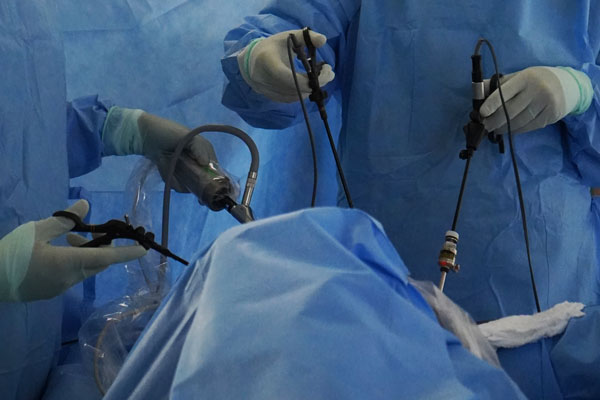Get the knowledge you need to diagnose and treat Endometriosis with the most advanced techniques used worldwide in the field to get the visibility your career needs and deserves.
Fill in the fields with the required information to receive the first hand invitation to our course.
A silent disease with echoes in every aspect of a woman’s life
- According to the National Health Surveillance Agency (ANVISA), approximately 10% of the female population suffers from Endometriosis;
- The disease is most common in women between the ages of 25 and 35, when they are at the peak of their professional lives and fertility;
- The impact of the disease ranges from difficulty conceiving to work-related infertility;
- Pain and stigma accompany these patients, and you can be an agent of transformation in the lives of each one of them;
- Transform your patients' lives and your own career with the qualifications you need to stand out.
Overcome the challenges of identifying and diagnosing endometriosis
Endometriosis is a difficult disease to diagnose, often causing years of discomfort, pain, and fertility problems due to gynecologists' lack of preparation to detect signs of the disease that may go beyond the symptoms.
Endo Masterclass is an online course entirely focused on the diagnosis, surgical and non-surgical treatment of Endometriosis, a disease that begins silently but can echo in every area of a woman's life.
You can stand out in your field, earn more for your expertise, and still make a difference in the lives of those who seek you out.
In addition, you will be able to solve other common pains for Gynecologists regarding the detection and treatment of Endometriosis, such as:

Reduce Endometriosis complications and make its surgical treatment more efficient
Learn anywhere from world-renowned Endometriosis physicians, become an expert, and perform your surgeries with greater assertiveness and safety.
Understand the interactions of Endometriosis with different parts of the body and learn how to refer your patients for multidisciplinary and much more long-lasting treatment.
Who are the mentors
Prof. Dra. Helizabet Salomão Abdalla Ayroza Ribeiro
- Assistant Professor at the School of Medical Sciences of Santa Casa de São Paulo
- Head of the Gynecological Endoscopy and Endometriosis Department at Santa Casa de São Paulo
- President of the Brazilian Endometriosis Society – SBE
- Vice-president of the National Endometriosis Commission CNE-Febrasgo

Dr. João Siufi Neto
- Surgical Oncologist
- Research Fellow at Mayo Clinic Arizona
- PhD student at the University of São Paulo
- Specialist in Minimally Invasive Surgery
- Working in the main hospitals in São Paulo

Prof. Dr. Maurício Abrão
- Professor Associado, Coordenador do Setor de Endometriose do Departamento de Obstetrícia e Ginecologia da FMUSP
- Gestor do Serviço de Ginecologia do Hospital BP – Beneficência Portuguesa de São Paulo
- Presidente American Association of Gynecologic. Laparoscopists (AAGL) 2022

Prof. Dr. Paulo Ayroza Ribeiro
- Professor Adjunto da Faculdade de Ciências Médicas da Santa Casa de São Paulo
- Chefe da Clínica de Cirurgia Ginecológica do Departamento de Obstetricia e Ginecologia da Santa Casa De São Paulo
- Presidente da Comissão Especializada em Endoscopia Ginecológica da Febrasgo
- Diretor Científico da SBE (Sociedade Brasileira de Endometriose e Ginecologia Minimamente Invasiva)

Treat your patients' health, not just the disease
Endometriosis is a disease that requires a holistic approach. Master the technical domain of all the elements that form the disease equation:
Anatomy
Hormones
Socioemotional aspects
Do more than treat the disease, exercise the ability to welcome your patient and offer assertive but also more humane treatment.
Schedule
Current aspects of the pathophysiology and diagnosis of endometriosis
Etiology and epidemiology: current concepts about an ancient disease
Immunology of Endometriosis: Current Aspects
Importance of the Multidisciplinary Approach to Endometriosis
Correlation of physical examination with imaging diagnosis
Pathophysiology of Infertility
Proteomics, metabolomics and future perspectives for subsidiary diagnosis
Markers for diagnosis over the years
New diagnostic methods for endometriosis
Current aspects of the pathophysiology and Diagnosis of Endometriosis
Anatomy as the basis of diagnostic and therapeutic reasoning for endometriosis
Endometriosis and Cancer: what is the evidence
Endometriosis and cancer
Critical analysis of the most important points of the anamnesis and clinical examination of the disease
Peritoneal, ovarian and deep endometriosis: three diseases?
Urogynecological assessment in patients with endometriosis: when and how?
Clinical examination applied to nerve involvement: understanding dermatomes. Evidence-based approach for the Clinical and Surgical diagnosis of endometriosis
Anatomic-clinical correlation of each type of pelvic pain
Image: the key to effective treatment
The New Classification of Endometriosis
History of imaging exams: where we came from and where we are going
The development of ultrasound specialized in endometriosis
Image analysis in cases of anterior compartment endometriosis
MRI applied to endometriosis
Ultrasound or resonance a critical and practical analysis
The integration of methods from the gynecologist’s perspective
Image analysis in cases of posterior compartment endometriosis
Endometriosis and Infertility
The diagnostic script for the patient with endometriosis and reproductive desire
- Critical analysis of surgical treatment vs. IVF for the treatment of infertile women
Decision making in infertility
Step-by-step gamete cryopreservation before surgery
Risks and care of surgical treatment and assisted fertilization for patients with endometriosis
Drug Treatment of Endometriosis
Hormonal treatment of endometriosis: treating symptoms or the disease?
Modern options for treating chronic pain in endometriosis patients
Choosing the ideal treatment for each patient
Fibrosis as a therapeutic target: when and why?
How to manage endometriosis after menopause
Surgical treatment of ovarian and peritoneal endometriosis
Peritoneal disease: is there room for peritoniectomy?
Surgical treatment of ovarian endometriosis: cystectomy or not? Application of laser or argon plasma in the treatment of endometriomas
Is there room for aspiration or intracystic injection of medications into endometriomas?
Surgical treatment of ovarian endometriosis
Different forms of energy for the surgical treatment of endometriosis
How to prevent adhesions
Modern evidence for robotic surgery for the treatment of endometriosis
Resources available to prevent adhesions in endometriosis surgeries
Surgical treatment of deep endometriosis
“Tips and Tricks” for the treatment of deep endometriosis without intestinal involvement
How to surgically treat diaphragm endometriosis
Endometriosis affecting the bladder and ureter: how to treat
Lumpectomy in intestinal endometriosis: when and what are the options?
Segmental resection in intestinal endometriosis: when and what are the options?
Therapeutic algorithms for the treatment of deep endometriosis in patients with pain and infertility
Our tips for safe surgery
CRONOGRAMA
Current aspects of the pathophysiology and diagnosis of endometriosis
Etiology and epidemiology: current concepts about an ancient disease
Immunology of Endometriosis: Current Aspects
Importance of the Multidisciplinary Approach to Endometriosis
Correlation of physical examination with imaging diagnosis
Pathophysiology of Infertility
Proteomics, metabolomics and future perspectives for subsidiary diagnosis
Markers for diagnosis over the years
New diagnostic methods for endometriosis
Current aspects of the pathophysiology and Diagnosis of Endometriosis
Anatomy as the basis of diagnostic and therapeutic reasoning for endometriosis
Endometriosis and Cancer: what is the evidence
Endometriosis and cancer
Critical analysis of the most important points of the anamnesis and clinical examination of the disease
Peritoneal, ovarian and deep endometriosis: three diseases?
Urogynecological assessment in patients with endometriosis: when and how?
Clinical examination applied to nerve involvement: understanding dermatomes. Evidence-based approach for the Clinical and Surgical diagnosis of endometriosis
Anatomic-clinical correlation of each type of pelvic pain
Image: the key to effective treatment
The New Classification of Endometriosis
History of imaging exams: where we came from and where we are going
The development of ultrasound specialized in endometriosis
Image analysis in cases of anterior compartment endometriosis
MRI applied to endometriosis
Ultrasound or resonance a critical and practical analysis
The integration of methods from the gynecologist’s perspective
Image analysis in cases of posterior compartment endometriosis
Endometriosis and Infertility
The diagnostic script for the patient with endometriosis and reproductive desire
Critical analysis of surgical treatment vs. IVF for the treatment of infertile women
Decision making in infertility
Step-by-step gamete cryopreservation before surgery
Risks and care of surgical treatment and assisted fertilization for patients with endometriosis
Drug Treatment of Endometriosis
Hormonal treatment of endometriosis: treating symptoms or the disease?
Modern options for treating chronic pain in endometriosis patients
Choosing the ideal treatment for each patient
Fibrosis as a therapeutic target: when and why?
How to manage endometriosis after menopause
Surgical treatment of ovarian and peritoneal endometriosis
Peritoneal disease: is there room for peritoniectomy?
Surgical treatment of ovarian endometriosis: cystectomy or not? Application of laser or argon plasma in the treatment of endometriomas
Is there room for aspiration or intracystic injection of medications into endometriomas?
Surgical treatment of ovarian endometriosis
Different forms of energy for the surgical treatment of endometriosis
How to prevent adhesions
Modern evidence for robotic surgery for the treatment of endometriosis
Resources available to prevent adhesions in endometriosis surgeries
Surgical treatment of deep endometriosis
“Tips and Tricks” for the treatment of deep endometriosis without intestinal involvement
How to surgically treat diaphragm endometriosis
Endometriosis affecting the bladder and ureter: how to treat
Lumpectomy in intestinal endometriosis: when and what are the options?
Segmental resection in intestinal endometriosis: when and what are the options?
Therapeutic algorithms for the treatment of deep endometriosis in patients with pain and infertility
Our tips for safe surgery
FREQUENTLY ASKED
QUESTIONS
Who is the Endo Masterclass course for?
What is the differential of this course?
The course program is entirely focused on solving the pains and gaps seen by these physicians in decades of experience and based on scientific evidence collected by them over the years.

